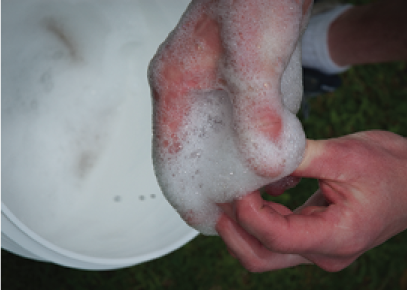Growing grapes is a lot of work. In addition to wildlife, many varieties are susceptible to disease that, if unprotected against, can claim your vines very quickly. Two pros from different regions detail how they protect their vines from disease.
 Winemaker: Bernie Parker, Oliver Winery, Bloomington, Indiana
Winemaker: Bernie Parker, Oliver Winery, Bloomington, Indiana
For south-central Indiana where we usually have cool, damp springs followed by humid summers with plenty of rain, our biggest threats that we are spraying against are black rot, phomopsis, and downy mildew.
We develop a spraying plan at the beginning of the season to ensure we are rotating chemicals by FRAC (fungicide resistance action committee) code and between systemic and residual sprays. We then will purchase the pesticides for the first 1⁄2 to 3⁄4 of the season. This allows us the flexibility to alter the schedule as needed due to problems that develop or the need to conduct timely canopy management.
Our general routine consists of Roper Rainshield at the beginning of the season and then we alternate it with systemic products like Pristine and Quadris Top. We also rotate products with different FRAC codes to help reduce resistance problems. When we reach the pre-harvest interval (PHI) for Roper (mancozeb) we shift to
Captan for phomopsis and downy mildew, and continue the rotation with other products.
We start with our first spray in April when the shoots are out about a 1⁄2 inch (1.25 cm). We continue through June on a 7–10 day interval. Then in July, if the weather permits, we can extend that to 10–14 day intervals until the middle of August. After that we will spray on an as-needed basis depending on scouting to identify problem areas that require attention. After harvest we may put on a fungicide spray to prevent premature leaf loss.
Weather plays a huge part in determining the intervals between sprays and also the rate at which products are applied. If the conditions are very favorable for a certain disease then we would protect against that by applying the higher recommended rate. If we are using a residual (surface protectant) type of fungicide, its effectiveness can be reduced by rain washing it off. In these cases we may re-spray a field, with a different fungicide if necessary to ensure proper spray intervals as required by the pesticide label are maintained. A systemic pesticide’s effectiveness is not necessarily reduced by weather, but if weather conditions are favorable for a disease and there has been a significant amount of growth after the pesticide was applied it may be prudent to spray again, since most systemic pesticides do not translocate into new growth.
We grow 17 grape varieties and many have different susceptibility to diseases, and therefore are treated differently. For instance, Pinot Gris and Vignoles are highly susceptible to Botrytis. These two varieties have very tight clusters compared to the other varieties we grow, such as Chambourcin and Vidal Blanc. So for these grapes with the tighter clusters we add an additional pesticide for Botrytis 3 to 4 times during the growing season. We also ensure the clusters are exposed by leaf pulling and shoot positioning to help them dry out quickly, reducing the losses caused by Botrytis.
Due to the weather conditions in the Midwest, we feel that organic farming on our scale is not feasible.

Winemaker: Wes Hagen, J. Wilkes Wines in Santa Maria, California
In the Santa Maria (coastal) Valley of California the biggest threats that we spray for are powdery mildew and Botrytis. For the first few sprays of the year we use sulfur/copper (Bordeaux mixture) and then after that we use wettable sulfur or Stylet-Oil for organic sprays, or synthetics such as Flint or Rally work well if you have access to them in your locale. It’s important to mix up modes of action as often as possible to keep the risk of mildew adaptation/resistance minimal.
How often spraying should be done is impacted by the conditions in the vineyard. Fog, temperatures from 75–85 °F (24–29 °C), rain, and high humidity will cause higher pressure and require more frequent spraying — but always follow intervals and concentrations listed on the labels. If the label says to spray every 7–14 days, the more frequent seven days should be the spraying interval in strong pressure, whereas with low fungus pressure 14 days will work. If you see disease (mildew/rot), the war is already lost.
Also keep in mind that hybrid vines have a much higher resistance to disease than European vinifera vines.
Spraying a vine that has been leaf plucked provides much better coverage. If your vines have 1+ leaf layer between the spray rig and the clusters you will NOT get coverage. An open canopy helps a vine in so many ways, but it’s a balancing act as you also have to leave the clusters protected from potential sunburn in warm or hot areas.
Spraying in the vineyard is an important process, even if you want to maintain an organic vineyard. Many “chemicals” are organic, such as Stylet-Oil or elemental sulfur. I would not produce wine without sprays because of mildew pressure. Some hybrid or native US vines can be grown without fungicide, but almost all vinifera vines will require a spray routine.
 Winemaker: Bernie Parker, Oliver Winery, Bloomington, Indiana
Winemaker: Bernie Parker, Oliver Winery, Bloomington, Indiana





